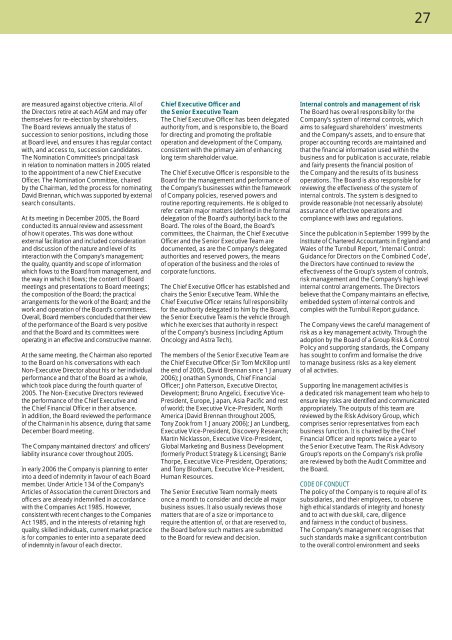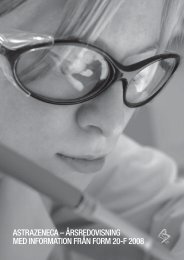AstraZeneca Annual Review 2005 - AstraZeneca Annual Reports
AstraZeneca Annual Review 2005 - AstraZeneca Annual Reports
AstraZeneca Annual Review 2005 - AstraZeneca Annual Reports
You also want an ePaper? Increase the reach of your titles
YUMPU automatically turns print PDFs into web optimized ePapers that Google loves.
27are measured against objective criteria. All ofthe Directors retire at each AGM and may offerthemselves for re-election by shareholders.The Board reviews annually the status ofsuccession to senior positions, including thoseat Board level, and ensures it has regular contactwith, and access to, succession candidates.The Nomination Committee’s principal taskin relation to nomination matters in <strong>2005</strong> relatedto the appointment of a new Chief ExecutiveOfficer. The Nomination Committee, chairedby the Chairman, led the process for nominatingDavid Brennan, which was supported by externalsearch consultants.At its meeting in December <strong>2005</strong>, the Boardconducted its annual review and assessmentof how it operates. This was done withoutexternal facilitation and included considerationand discussion of the nature and level of itsinteraction with the Company’s management;the quality, quantity and scope of informationwhich flows to the Board from management, andthe way in which it flows; the content of Boardmeetings and presentations to Board meetings;the composition of the Board; the practicalarrangements for the work of the Board; and thework and operation of the Board’s committees.Overall, Board members concluded that their viewof the performance of the Board is very positiveand that the Board and its committees wereoperating in an effective and constructive manner.At the same meeting, the Chairman also reportedto the Board on his conversations with eachNon-Executive Director about his or her individualperformance and that of the Board as a whole,which took place during the fourth quarter of<strong>2005</strong>. The Non-Executive Directors reviewedthe performance of the Chief Executive andthe Chief Financial Officer in their absence.In addition, the Board reviewed the performanceof the Chairman in his absence, during that sameDecember Board meeting.The Company maintained directors’ and officers’liability insurance cover throughout <strong>2005</strong>.In early 2006 the Company is planning to enterinto a deed of indemnity in favour of each Boardmember. Under Article 134 of the Company’sArticles of Association the current Directors andofficers are already indemnified in accordancewith the Companies Act 1985. However,consistent with recent changes to the CompaniesAct 1985, and in the interests of retaining highquality, skilled individuals, current market practiceis for companies to enter into a separate deedof indemnity in favour of each director.Chief Executive Officer andthe Senior Executive TeamThe Chief Executive Officer has been delegatedauthority from, and is responsible to, the Boardfor directing and promoting the profitableoperation and development of the Company,consistent with the primary aim of enhancinglong term shareholder value.The Chief Executive Officer is responsible to theBoard for the management and performance ofthe Company’s businesses within the frameworkof Company policies, reserved powers androutine reporting requirements. He is obliged torefer certain major matters (defined in the formaldelegation of the Board’s authority) back to theBoard. The roles of the Board, the Board’scommittees, the Chairman, the Chief ExecutiveOfficer and the Senior Executive Team aredocumented, as are the Company’s delegatedauthorities and reserved powers, the meansof operation of the business and the roles ofcorporate functions.The Chief Executive Officer has established andchairs the Senior Executive Team. While theChief Executive Officer retains full responsibilityfor the authority delegated to him by the Board,the Senior Executive Team is the vehicle throughwhich he exercises that authority in respectof the Company’s business (including AptiumOncology and Astra Tech).The members of the Senior Executive Team arethe Chief Executive Officer (Sir Tom McKillop untilthe end of <strong>2005</strong>, David Brennan since 1 January2006); Jonathan Symonds, Chief FinancialOfficer; John Patterson, Executive Director,Development; Bruno Angelici, Executive Vice-President, Europe, Japan, Asia Pacific and restof world; the Executive Vice-President, NorthAmerica (David Brennan throughout <strong>2005</strong>,Tony Zook from 1 January 2006); Jan Lundberg,Executive Vice-President, Discovery Research;Martin Nicklasson, Executive Vice-President,Global Marketing and Business Development(formerly Product Strategy & Licensing); BarrieThorpe, Executive Vice-President, Operations;and Tony Bloxham, Executive Vice-President,Human Resources.The Senior Executive Team normally meetsonce a month to consider and decide all majorbusiness issues. It also usually reviews thosematters that are of a size or importance torequire the attention of, or that are reserved to,the Board before such matters are submittedto the Board for review and decision.Internal controls and management of riskThe Board has overall responsibility for theCompany’s system of internal controls, whichaims to safeguard shareholders’ investmentsand the Company’s assets, and to ensure thatproper accounting records are maintained andthat the financial information used within thebusiness and for publication is accurate, reliableand fairly presents the financial position ofthe Company and the results of its businessoperations. The Board is also responsible forreviewing the effectiveness of the system ofinternal controls. The system is designed toprovide reasonable (not necessarily absolute)assurance of effective operations andcompliance with laws and regulations.Since the publication in September 1999 by theInstitute of Chartered Accountants in England andWales of the Turnbull Report, ‘Internal Control:Guidance for Directors on the Combined Code’,the Directors have continued to review theeffectiveness of the Group’s system of controls,risk management and the Company’s high levelinternal control arrangements. The Directorsbelieve that the Company maintains an effective,embedded system of internal controls andcomplies with the Turnbull Report guidance.The Company views the careful management ofrisk as a key management activity. Through theadoption by the Board of a Group Risk & ControlPolicy and supporting standards, the Companyhas sought to confirm and formalise the driveto manage business risks as a key elementof all activities.Supporting line management activities isa dedicated risk management team who help toensure key risks are identified and communicatedappropriately. The outputs of this team arereviewed by the Risk Advisory Group, whichcomprises senior representatives from eachbusiness function. It is chaired by the ChiefFinancial Officer and reports twice a year tothe Senior Executive Team. The Risk AdvisoryGroup’s reports on the Company’s risk profileare reviewed by both the Audit Committee andthe Board.CODE OF CONDUCTThe policy of the Company is to require all of itssubsidiaries, and their employees, to observehigh ethical standards of integrity and honestyand to act with due skill, care, diligenceand fairness in the conduct of business.The Company’s management recognises thatsuch standards make a significant contributionto the overall control environment and seeks




